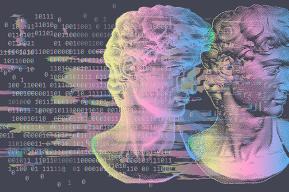Article
Rethinking technodiversity

Yuk Hui
In 1914 during the outbreak of the First World War, the French philosopher Henri Bergson gave an inaugural speech titled “Meaning of the War” as the newly elected president of the Académie des Sciences Morales et Politiques. Bergson, who later became the president of the International Committee on Intellectual Cooperation (the ancestor of UNESCO), accused Germany of “machinism” and “mechanism” – these terms appear many times in his short speech. It was machinism and mechanism which led Germany from being a country of music, poetry and metaphysics, to a “scientific barbary” and “systematic barbary”.
Bergson saw the development of mechanical science and technology as the source of the war; the 19th century had given “a wholly unforeseen extension to the mechanical arts and had equipped man in less than fifty years with more tools than he had made during the past thousands of years he had lived on the earth”. Each new machine being for man a new organ, the soul could no longer accommodate the dilating body. A similar analysis of war reappears in his later work The Sources of Morality and Religion (1932).
This incompatibility is the source of the hubris that we have witnessed in the past world wars, and today in the calls to return to a certain Volksgeist (national spirit). Bergson expressed his anger in a long list of questions, of which we singled out one: “What kind of a world would it become if this mechanism should seize the entire human race, and if the peoples, instead of elevating themselves to a richer and more harmonious diversity, as persons may do, were to fall into the uniformity of things?”
Uniformity versus diversity
Today, how are we going to understand Bergson’s diagnosis of the artificial organs, producing uniformity instead of diversity? It might be the case that we still fail to understand the significance of Bergson’s thesis. If there is a diversity of people, it is not because of their colour or race, but rather their different way of thinking, which we will call noodiversity (noo- comes from the Greek word nous - “mind” or “intellect”). The noodiversity has been maintained by a technodiversity, a variety of ways of understanding and constructing technology in different cultures, emerging from the locality and always in exchange with other localities.
If there is a diversity of people, it is not because of their colour or race, but rather their different way of thinking
Technodiversity and noodiversity are correlated, and in turn, they maintain the biodiversity of their living environment. The human factor is central to the maintenance of biodiversity—something that is self-evident to us today, especially when we consider that we have entered into what the geologists call the Anthropocene, the domination of human beings on the Earth. That is to say, both noodiversity and biodiversity depend more and more on a technodiversity.
This question of diversity has gradually disappeared in the past centuries for various reasons. Firstly, because of the misunderstanding of technology, one tended to think that technology is only an instrument. We may recall how, during modernization in the second half of the 19th century, East Asian countries thought that they could master Western technologies using their own thought. During this period, we found very similar slogans such as “Chinese substance and Western function”(中體西用), “Japanese soul and Western knowledge” (わこんようさい) or “Eastern Dao and Western instrument” (동도서기론 ).
All these movements share the conviction that Eastern thinking will be able to master Western science and technology, which are mere instruments. Today, we know this wishful thinking is only a variation of Cartesian dualism. Secondly, because of the triumph of positivism, which understands technology as universal, whose rationality is beyond time and space, we might say that technology possesses a universal dimension in so far as it is the externalization of memory and the extension of bodily organs. However, technology has also been shaped and constrained by locality and cosmology.
Limits of innovation
Joseph Needham, a British biochemist, historian of science and sinologist, and the first head of the Natural Sciences Section in UNESCO (1946-48), has raised the haunting “Needham’s question”, which asks why modern science and technology didn’t appear in China and India but only in Europe. Like many historians after Needham, one could, of course, argue that before the 16th century, many scientific discoveries and technological developments in China were more advanced than in Europe.
However, this betrayed what Needham was hinting at: for him, it is not legitimate to compare Western science and technology directly with the Chinese ones, since they carry rather different ontological and epistemological assumptions. As an example, ontological entities such as ch’i (vital breath) and yin, yang in Chinese medicine cannot be materially demonstrated in anatomy. Based on his own research in biology, Needham adopted the term “organicism” to describe Chinese medicine and Chinese thought in general.
In other words, Chinese and Western cultures have had different ways of understanding and constructing technology, and this is what I term technodiversity. This diversity is not only to be found in the past; we also need to think about it today. We are surrounded by digital technologies; however, we rarely question the ontological and epistemological assumptions already made in these products. Take the example of social networks: they already presuppose that society is a collection of social atoms and that human relations can be known and studied via data connectivity.
Once questioned, these presuppositions will appear problematic, because they were developed in the 1930s by social psychologists such as Romanian-American Jacob Moreno and German-American Kurt Lewin, and no anthropologist will agree that human society commenced with social atoms. However, this model has been imitated and amplified by almost all social network platforms found in different countries, whether it be Facebook, VKontakte or Wechat. This also shows the limit of innovation that we are talking about today, especially when it focuses only on efficiency and consumerism.
Reconciliation through diversification
Today, technological globalization has already made us ignore the question of technodiversity and turned the problem into an opposition between the global and the local, modern and traditional, West and East, without being able to open the question of diversity beyond identity. Pierre Teilhard de Chardin, a French Jesuit, archaeologist and theologist to whom UNESCO dedicated a symposium in 1981, proposed what he calls the convergence of the noosphere.
According to Teilhard’s theory, the evolution could be seen as an evolution of consciousness, which will realize a noosphere, through the invention and propagation of technology over the globe. For Teilhard, such a convergence is also a christogenesis. However, today we must add to his observation that this formation of the noosphere is also the process of technological competition and military expansion, and that in such formation, there is a homogenization instead of a diversification. Therefore, diversification could only happen at the most superficial level, namely that of national identity.
The quest and promotion of technodiversity should be one of the core tasks for us today
I feel that now, more than ever, we must come back to the question of technodiversity in view of the addictive consumerism, vicious economic competition and threatening military expansion that we are experiencing today; especially when we know that a unified global solution is difficult if not impossible, and a return to nationalism is far beyond desirable. What Bergson concluded in 1914 has not been altered; instead, such a tendency only continues with more powerful cybernetic machines, which, one could argue like American mathematician Norbert Wiener did, are no longer mere mechanisms that Bergson had in mind. The quest and promotion of technodiversity should be one of the core tasks for us today, as Bergson and Needham once urged.
UNESCO is probably the only body which is capable of putting forward this agenda far beyond what any individual thinker and academic community could achieve. This task consists of not only preserving the collective memory of the past, out of nostalgia or the obsolescence of mankind, but also preparing a new agenda to cultivate inspiration to think about tomorrow by constructing a scientific and cultural programme to reflect on our relations with each other and to other, non-human beings, and to the Earth in a less homogeneous way. Perhaps with such a diversification, we could shed some new light on new pathways out of this impasse.
Yuk Hui
Philosopher and teacher at the City University of Hong Kong, Yuk Hui wrote his doctoral thesis under the French philosopher Bernard Stiegler at Goldsmiths College in London. His monographs, translated into a dozen languages, include On the Existence of Digital Objects (2016), The Question Concerning Technology in China: An Essay in Cosmotechnics (2016), Recursivity and Contingency (2019), and Art and Cosmotechnics (2021).
More articles from Ideas







